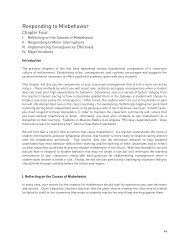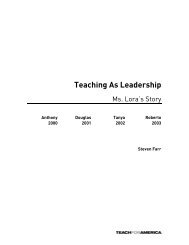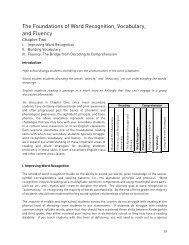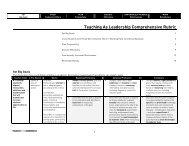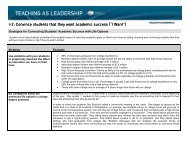The Power of High Expectations - Teaching As Leadership
The Power of High Expectations - Teaching As Leadership
The Power of High Expectations - Teaching As Leadership
You also want an ePaper? Increase the reach of your titles
YUMPU automatically turns print PDFs into web optimized ePapers that Google loves.
<strong>The</strong> <strong>Power</strong> <strong>of</strong> <strong>High</strong> <strong>Expectations</strong><br />
<strong>As</strong> further described in <strong>Teaching</strong> <strong>As</strong> <strong>Leadership</strong> through the research <strong>of</strong> Jeff Howard, the self-fulfilling<br />
prophecy <strong>of</strong> low and high expectations applies to students as well as teachers. Students have been<br />
shown to achieve more when they believe their teachers and society expect that they will achieve at high<br />
levels. And unfortunately, they achieve less when less is expected <strong>of</strong> them: “[C]hildren may bring to the<br />
classroom a lifetime <strong>of</strong> being told that they are failures, or even worse, that they are developmentally<br />
disabled.” 40<br />
It is easy to equate success to race and<br />
background, but doing so will be your<br />
demise as a teacher. If you show your<br />
students that success is attainable through<br />
perseverance, and teach them to be selfpropelled<br />
and self-motivated, then their<br />
background will become obsolete. It is<br />
simple to blame failure on background; the<br />
greater challenge is to teach well.<br />
Katherine Smith, Delta ‘02<br />
COO, NYC Department <strong>of</strong> Education<br />
32<br />
With the last chapter, you read Pr<strong>of</strong>essor Ogbu’s chapter on<br />
various explanations for the achievement gap. Consider<br />
Pr<strong>of</strong>essor Ogbu’s treatment <strong>of</strong> teacher expectations. Note<br />
that Pr<strong>of</strong>essor Ogbu contends that “low teacher expectations”<br />
is a more complicated phenomenon than some analysts<br />
indicate, and he asks us to consider the degree to which<br />
students themselves influence teacher expectations. How<br />
does this contention support or contradict our assertion here<br />
that low expectations more generally (including low<br />
expectations by teachers, society, families, and the students<br />
themselves) are a hugely damaging influence that we, as<br />
teachers, actually can take on and conquer?<br />
“Racism, Discrimination, and <strong>Expectations</strong> <strong>of</strong> Students’ Achievement”<br />
Along with this chapter, you will read another book excerpt. “Racism, Discrimination, and <strong>Expectations</strong> <strong>of</strong><br />
Students’ Achievement,” 41 is by Pr<strong>of</strong>essor Nieto, author <strong>of</strong> the previous block quote, and one <strong>of</strong> the<br />
country’s leading experts on diversity issues in the education context. In the piece that you will read,<br />
Nieto directly takes on the interrelations between conscious and unconscious biases and the low<br />
expectations that are so damaging to students.<br />
In her chapter, Nieto contends that deep-seated, <strong>of</strong>ten unconscious, prejudices held by teachers,<br />
administrators and policy makers <strong>of</strong>ten manifest in the education structures <strong>of</strong> our schools and the<br />
education experiences <strong>of</strong> our students. She argues that social ills <strong>of</strong> racism, sexism, and other types <strong>of</strong><br />
discrimination are embedded in schools’ practice and design as much as they are in society at large.<br />
Nieto contends that this discrimination is not only revealed through the actions (<strong>of</strong>ten resulting from<br />
unconscious prejudices) <strong>of</strong> teachers, but through student outcomes like drop-out rates, college<br />
attendance, and other indicators <strong>of</strong> educational failure or success.<br />
One <strong>of</strong> Nieto’s fundamental theses is that not only are teacher expectations critical to student success,<br />
but that many teachers fail to realize that they have diminished expectations <strong>of</strong> their students in the first<br />
place. <strong>As</strong> you read this article, think critically about your own perspectives on students in your future<br />
classroom. Is there any degree to which you too, despite the best <strong>of</strong> intentions, tend to see the different<br />
backgrounds <strong>of</strong> students not as an asset, but "rather as an obstacle to be overcome?" Are you tempted to<br />
relax expectations <strong>of</strong> students out <strong>of</strong> sympathy or pity? And do you recognize the damage that such a<br />
relaxation <strong>of</strong> standards can cause? <strong>The</strong>se are obviously not easy questions to answer, and honest<br />
answers are <strong>of</strong>ten painful. But, as Nieto indicates, students’ achievement depends on teachers’ frank<br />
exploration <strong>of</strong> their own deep-seated beliefs and expectations.<br />
40 Texeira, Mary <strong>The</strong>irry and Christian, Pamela Merchant. “And Still <strong>The</strong>y Rise: Practical Advice for Increasing African American<br />
Enrollments in <strong>High</strong> Education.” Educational HORIZONS, Spring 2002, p. 117-118.<br />
41 This reading is Chapter 4 <strong>of</strong> Sonia Nieto & Patty Bode’s Affirming Diversity: <strong>The</strong> Sociopolitical Context <strong>of</strong> Multicultural Education,<br />
White Plains, NY: Longman Publishers USA, 2008.



